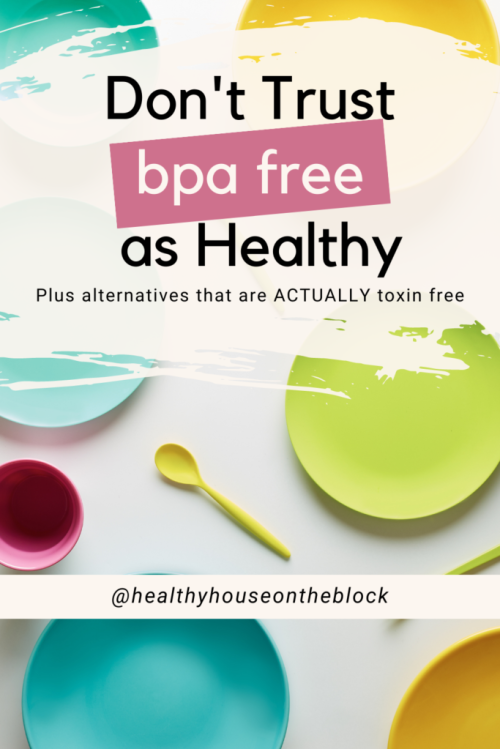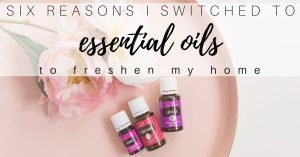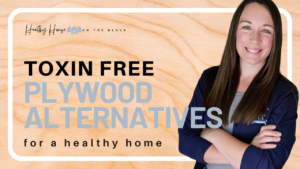
So often we just hear that plastic should be avoided in the kitchen and other areas of our homes, but really, do we know why? For a long time, I really felt unclear as to WHY plastic was one of the most harmful materials in my home. But once I started researching the properties of plastic, and especially plastic containing bisphenol, I quickly realized just WHY this material should be avoided.
It all started back when my first daughter was born in 2012. BPA had just been banned from many children’s plastics, including baby bottles. I had found some BPA free bottles to put on my registry and felt like I was making a REALLY positive choice. But something nagging inside me as my kids grew questioned why some companies were making glass baby bottles. Why would glass be better if my plastic bottles didn’t contain any BPA?

I soon realized what I had a sneaking suspicion of, BPA was regulated and banned in some products in the US, but the replacement for BPA was just as bad. I learned this through seeking out the information, it was never given to me or told to me in a report. Instead, all the research and news focused on finding products that are BPA free and how healthy it was to use plastic that had no bisphenol A making it up.
Unfortunately, there is still the misconception that BPA free plastic is safe for use. And as we go through this deep dive into Bisphenol as a whole, you’ll see that it definitely is not a safe toxin.
WHAT IS BISPHENOL?
Bisphenol is a chemical toxin in compound form that is used primarily in plastics as well as epoxy resins. Bisphenol is produced in large quantities due to the amount of plastic we have in our world. Bisphenol is manufactured using a variety of different exact formulas, and this is why there are so many different labels and letters to classify this plastic component.
Bisphenol A (BPA): This is the most common type of bisphenol, and you’ve likely heard A LOT about this one. It is the component of plastic that has gotten so much attention publicly. Most plastic products now boast “BPA free”, but as we’ll see in these next paragraphs, that isn’t always a safe option. Often labelled with a “7” on recyclables.
Bisphenol B (BPB): Bisphenol B has similar properties to Bisphenol A when we’re talking about the endocrine disrupting properties. The structure of the actual chemical is very similar and the health effects appear to be very similar in various research studies. BPB is another toxin that is being found in urine and breastmilk in high concentrations due to constant exposure. Manufacturers are not required to disclose if BPB is present in any food packaging or plastic items.
Bisphenol S (BPS): Bisphenol S is a cousin of BPA and commonly found in can linings, thermal receipt paper and other plastic products. It has similar health risks to BPA, and yet it is widely used without disclosure. The pathways that BPS takes in the body are very different than BPA, yet they have similar outcomes in terms of health effects.
Bisphenol F (BPF): While BPF is currently replacing BPA in many products, it still has a very similar chemical makeup that has health effects that are similar in nature as well. Bisphenol F is actually prepared by using a reaction of phenol and formaldehyde as a mixture. BPF is most often used in epoxy resins and adhesives (RESEARCH)
While there are a plethora of other bisphenols out there, the only one that is truly regulated is BPA. As you read on, you’ll see that the health effects of ANY bisphenol are harmful to adults, children and unborn babies. Yet, the only chemical compound that has so far been banned in some products and regulated in use is BPA. It’s simply replacing one toxic compound of bisphenol A (BPA) with another equally toxic material. However, now, the product can boast BPA free making us all feel like this is a green and safe product. In actuality, a BPA free plastic item is JUST as harmful as one that contains BPA.

HEALTH EFFECTS OF BISPHENOL
Over 90% of individuals in the United States carry bisphenol in their bodies. What’s alarming is that our bodies actually break down and remove bisphenol within just a few days. The fact that there are measurable amounts within MOST humans in the US means we are taking bisphenol in as fast as our bodies can get rid of it. (STUDY)
Bisphenol A has been shown to alter hormone production in the brain. It is known as an endocrine-active chemical. It also alters the cell and tissues receiving the hormones as it works mimicking estrogen. (STUDY) It was also recently linked to an increased risk of childhood asthma when children were exposed to the chemical at an early age or in utero. (STUDY)
Another study from 2018 compared concentrations of BPA, BPB, BPF and BPF in rats and it’s negative effects on the reproductive system. The study suggests that ALL forms of bisphenol are toxic and reduce the amount of testosterone produced in males. (STUDY) Bisphenol B also chronic reproductive problems and cessation in another study done on fish and aquatic life (STUDY).
Bisphenol S, which has been replacing BPA in food packaging and containers, has been shown to leach into water and food with several negative health effects. A study from February of 2020 shows that although BPS works through different pathways than BPA, it still causes the equivalent health effects of endocrine disruption, gestational diabetes and metabolic disorders. The study also showed that BPS was actually MORE toxic to the reproductive system as well as linked it to the promotion of certain breast cancers. (STUDY)
Bisphenol F is found in much lower quantities around the United States, however it still has health effects that are similar to BPA. BPF is metabolized rapidly, and while it does not stay in the body for long, the fact that it is present in our bodies shows that we are being constantly exposed. BPF mimics estrogenic activity and has been linked to obesity. (STUDY)

PRODUCTS THAT CONTAIN BISPHENOL
While MANY products made after 2011 and 2012 do not contain BPA, many of these items now contain another form of bisphenol. To specifically avoid BPA, look for the “7” on the recycle label of a plastic product.
- Canned Foods (BPB)
- Thermal Receipt Paper (BPF)
- Hard plastic sports bottles (BPS)
- Food Wrap (BPS)
- Deli Containers (BPS)
- Plastic Utensils (BPS)
- Non-Stick Cookware (BPS)
- Plastic Food Storage Containers (BPS)
- Plastic Baby Bottles and Components (BPS)
- Canned Drinks (BPS)
- Sippy Cups
- Personal Care Products (BPF)
- Caulks & Adhesives
- Vinyl Flooring
- Teething Toys
HOW TO AVOID BISPHENOL IN ANY FORM
I think the best and easiest way to reduce exposure to bisphenol in your home is to ditch your plastic wherever you can, but especially in the kitchen. Some of my favorite alternatives for storing food in non-plastic materials are:
And once you start looking around your kitchen, you’ll notice other items that can EASILY be replaced with a more natural material. The list below can get you started, or this post can help which goes more in depth.
- Stainless Steel Water bottles
- Ceramic or Stainless Steel Cookware
- Ceramic Plates and Dishes
- Bamboo Recyclable Utensils
Also, avoid touching receipts when possible as the BPF and BPS that are present in the thermal paper is easily absorbed through our skin (RESEARCH).
I also think that replacing kids toys and teethers with plastic free alternatives is a great practice. My post about natural and plastic free kids’ toys is a perfect way to get you started.

Share this:
- Click to share on Facebook (Opens in new window) Facebook
- Click to share on LinkedIn (Opens in new window) LinkedIn
- Click to share on Reddit (Opens in new window) Reddit
- Click to share on Pinterest (Opens in new window) Pinterest
- Click to print (Opens in new window) Print
- Click to share on X (Opens in new window) X




Pingback: Plastic Free Coffee Makers & Eco Friendly Coffee Accessories »
Pingback: Tried & True NonToxic Kids Lunch Box Options »
Pingback: Toxin Free Workout Equipment for Home (Plus Organic Workout Gear) - Healthy House on the Block
Pingback: Is Silicone Safe to Use in Kitchens and Around the House? - Healthy House on the Block
Pingback: Steps to Creating the Ultimate Healthy Kitchen -
Pingback: Healthy Windows: Best Windows | Toxin Free Blinds | Organic Curtains - Healthy House on the Block
Pingback: Healthy Windows: Best Windows | Toxin Free Blinds | Organic Curtains - Healthy House on the Block